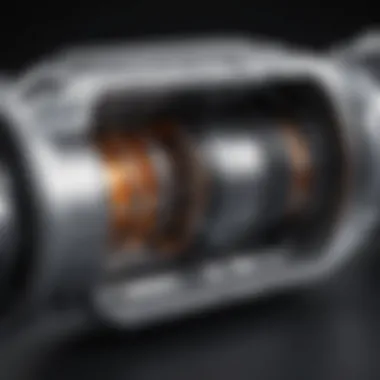In-Depth Look at Catalytic Converters in Vehicles


Intro
Catalytic converters, little metal boxes hidden beneath vehicles, serve as unsung heroes in the realm of automotive engineering. They are not just mere components; they play a pivotal role in controlling emissions that cause environmental havoc. As society becomes more aware of ecological preservation, the automotive world is evolving, and catalytic converters are at the forefront of this change.
In this piece, we dive into the intricate workings of these devices, shedding light on their design and operation, while placing a spotlight on the environmental benefits they offer. We will also explore the challenges they encounter amid changing regulations and technological advancements. By the end, we aim to give automotive enthusiasts, buyers, and environmentally conscious consumers an enriched understanding of why catalytic converters matter in today’s vehicles and how they might evolve in the near future.
Understanding Catalytic Converters
Catalytic converters play a crucial role in the realm of modern automotive technology, transcending mere components to become central players in the dialogue surrounding environmental accountability and vehicular efficiency. As we dissect various elements that surround catalytic converters, it becomes essential to grasp not only what they are but also their multifaceted purpose. This section sheds light on their definition and historical significance, paving the way for an in-depth understanding of these essential devices.
Definition and Purpose
At its core, a catalytic converter is an exhaust emission control device that converts toxic gases and pollutants generated by internal combustion engines into harmless substances. It operates mainly by facilitating chemical reactions that change harmful emissions—such as carbon monoxide, hydrocarbons, and nitrogen oxides—into less harmful emissions, primarily carbon dioxide and nitrogen.
The purpose of a catalytic converter extends beyond just reducing pollution. By enabling vehicles to comply with stringent emission regulations set by governments across the globe, these devices contribute significantly to public health and environmental sustainability. Without the catalytic converter, the automotive industry would struggle to meet the evolving demands for cleaner air and more responsible fuel consumption. In short, these devices are not simply mechanical structures; they represent a pivotal commitment to ecological stewardship in everyday driving.
Historical Development
The journey of catalytic converters started in the mid-20th century, in an era where pollution was often an afterthought amid booming automobile production. Regulation began to dawn when the U.S. Clean Air Act was enacted in 1970, setting a new standard for emissions that challenged automotive manufacturers to innovate.
In the 1970s, the first generation of catalytic converters emerged, employing basic oxidation processes to tackle carbon monoxide and unburned hydrocarbons. As the world acknowledged the alarming effects of air pollution, more sophisticated designs were necessitated. By the late '80s, the three-way catalytic converter became a game changer, allowing for simultaneous oxidation and reduction reactions. This advancement enabled a more comprehensive approach to meeting emission standards, effectively addressing nitrogen oxides along with carbon monoxide and hydrocarbons.
The evolution of catalytic converters didn't halt there; as both technology and regulatory frameworks progressed, so too did the designs and materials used in manufacturing these vital components. The shift towards lean burn engines and the growing prevalence of diesel vehicles led to innovations like diesel oxidation catalysts. Each step forward highlights the vehicle industry's ongoing dance with efficiency, environmental responsibility, and technological ingenuity.
In summary, understanding catalytic converters' definitions and historical significance provides a critical foundation. As the automotive landscape continues to transform, these components are likely to adapt further in their complexity and efficiency, ensuring they remain central to achieving a sustainable future.
The Mechanism of Catalytic Converters
Understanding the mechanism of catalytic converters is key to grasping their vital role in modern automotive technology. Catalytic converters transform harmful gases produced during combustion into less harmful emissions before they exit the vehicle's exhaust system. This process is not only essential for maintaining compliance with environmental regulations, but it also contributes significantly to the overall efficiency of vehicle engines.
Chemical Reactions Involved
Chemical reactions are at the heart of catalytic converters. There are three primary categories that define these reactions: oxidation, reduction, and the role of catalysts. Each plays a distinct part in ensuring that the emissions from vehicles are minimized. Let's explore these in more depth.
Oxidation
Oxidation in the context of catalytic converters refers to the process where carbon monoxide (CO) and unburned hydrocarbons (HC) are converted into carbon dioxide (CO2) and water (O). This reaction occurs at high temperatures, making it effective for breaking down these harmful substances. A primary characteristic of oxidation is its efficiency in reducing the toxicity of engine emissions, thus acting as a beneficial choice for improving air quality.
The unique feature of oxidation lies in its ability to operate under a range of temperatures. However, it can sometimes lead to an increase in carbon dioxide levels, which is a greenhouse gas. Despite this drawback, oxidation remains crucial because it significantly decreases more acute pollutants present in engine exhaust.
Reduction
Reduction, on the other hand, deals with the conversion of nitrogen oxides (NOx) into nitrogen (N2) and oxygen (O2). The key characteristic of reduction is its ability to combat one of the more dangerous byproducts of combustion—a major contributor to air pollution and smog. This makes it a notable process in the sphere of emissions control.
Reduction's unique aspect is that it often requires the addition of hydrocarbons or ammonia to achieve maximum effectiveness. This need for additional substances can be seen as a disadvantage because it adds complexity to the system and can require more sophisticated engine management. Still, reduction is indispensable in addressing NOx emissions and thus plays a pivotal role in meeting regulatory standards.
Role of Catalysts
Catalysts are critical components in the functioning of catalytic converters, as they enable and accelerate the chemical reactions without undergoing permanent changes themselves. The importance of catalysts cannot be overstated; they lower the activation energy needed for the reactions to take place, effectively speeding up the process.
The fundamental advantage of having these catalysts is their ability to facilitate multiple reactions simultaneously. This capability enhances the overall efficiency of the exhaust system. However, they can also be sensitive to certain contaminants, which might hinder their performance and longevity. Overall, the role of catalysts is central to the performance and effectiveness of catalytic converters.
Types of Catalytic Converters
Catalytic converters are distinguished primarily by their configuration, which directly correlates to the types of emissions they address. A balanced understanding of these different types informs their application and efficacy in various automotive contexts.


Two-Way Catalytic Converters
Two-way catalytic converters focus primarily on oxidizing carbon monoxide and unburned hydrocarbons. The dominant characteristic of this type is its simplicity in design, which leads to lower production costs. Their limitation, however, is that they do not address nitrogen oxides, making them less effective in situations where NOx emissions are a concern.
The unique feature of two-way converters is that they perform exceptionally well on older vehicles that emit lower amounts of NOx. They are a pragmatic choice for certain applications, yet less stringent standards have led to a decline in their usage in favor of more comprehensive alternatives.
Three-Way Catalytic Converters
Three-way catalytic converters incorporate both oxidation and reduction processes, allowing them to convert carbon monoxide, unburned hydrocarbons, and nitrogen oxides within a single unit. The key characteristic of three-way converters is their versatility and effectiveness in minimizing all three major vehicle emissions.
This type offers the significant advantage of comprehensive emissions control, aligning with modern regulatory standards. However, they may become less effective under specific operating conditions, such as when the air-fuel ratio is not optimal, potentially leading to increased emissions.
Diesel Oxidation Catalysts
Diesel oxidation catalysts are specifically designed for diesel engines, functioning primarily to oxidize carbon monoxide and hydrocarbons while also reducing particulate levels. The defining feature of these catalysts is their ability to handle the unique exhaust profile of diesel engines.
One drawback is that they do not address nitrogen oxides, necessitating additional technology, like SCR (Selective Catalytic Reduction), for complete control. Nonetheless, diesel oxidation catalysts play an essential role in reducing harmful emissions from diesel vehicles.
Construction Materials
The effectiveness of catalytic converters depends heavily on the materials used in their construction. Key elements include the catalyst substrates, coatings, and support structures that dictate their overall performance.
Catalyst Substrates
Catalyst substrates form the foundation of the catalytic converter, determining the surface area available for reactions. This characteristic is fundamental to the efficiency of the converter—more surface area translates into a greater ability to facilitate reactions. Materials like ceramic and metallic foils are popular choices due to their durability and performance under high temperatures.
However, while ceramic substrates may offer better thermal stability, they can be more fragile than their metallic counterparts, which are more resilient under harsh conditions.
Coatings
Coatings refer to the thin layers of noble metals like platinum, palladium, and rhodium that are applied to the substrates to facilitate the catalytic reactions. The key characteristic of these coatings is their catalytic activity, significantly enhancing reaction rates. Each metal offers unique advantages; for instance, rhodium is particularly effective in catalytic reduction.
The unique challenge with coatings, however, is their cost; these precious metals can be expensive, leading to higher overall manufacturing costs of the converters. Despite that, their critical role in emissions reduction cannot be overlooked.
Support Structures
Support structures provide the necessary rigidity and stability to endure the physical demands of the exhaust system. The defining aspect of these structures is their capacity to maintain the integrity and position of the catalyst substrates under high heat and vibration conditions common in automotive applications.
The advantage of robust support structures is the extended lifespan of the catalytic converter, preventing premature failure. Conversely, overly heavy materials can lead to additional weight in the vehicle, potentially affecting fuel efficiency negatively.
The Environmental Impact of Catalytic Converters
The environmental impact of catalytic converters is a critical aspect of their design and operation. These devices play a vital role in reducing harmful emissions from vehicles, making them indispensable in the quest for cleaner air and a healthier planet. Through effective chemical processes, catalytic converters transform toxic substances into less harmful entities, ensuring that vehicles comply with stringent emission norms. Given the steady rise in vehicle numbers globally, understanding their environmental impact has never been more pressing.
Reduction of Harmful Emissions
Catalytic converters are chiefly responsible for the mitigation of several harmful emissions produced by internal combustion engines. This includes a trio of particularly notorious pollutants: carbon monoxide, hydrocarbons, and nitrogen oxides.
Carbon Monoxide
Carbon monoxide, a colorless and odorless gas, is a significant byproduct of fossil fuel combustion. It arises mainly when there is insufficient oxygen for complete combustion. The presence of carbon monoxide is concerning due to its high toxicity with effects ranging from impairing oxygen transport in the bloodstream to potential life-threatening situations.
Catalytic converters facilitate its conversion to carbon dioxide, a much less harmful gas. The ability to effectively reduce carbon monoxide emissions is one of the key reasons why modern vehicles include catalytic converters as standard equipment. The unique feature here is their capacity to address a persistently dangerous pollutant with relative ease, which is crucial for urban areas with high traffic density.
Hydrocarbons
Hydrocarbons, comprised of organic compounds, result from incomplete fuel combustion. They are harmful due to their potential to form ground-level ozone, which is a significant contributor to smog. Hydrocarbons also increase the risk of respiratory ailments among vulnerable populations, such as children and the elderly.


The catalytic converter tackles hydrocarbons by oxidizing them into water and carbon dioxide. This reaction is essential in improving air quality, making hydrocarbons another prime candidate influencing the necessity of catalytic converters in vehicles. Additionally, their capacity to significantly reduce these emissions results in a marked reduction in urban pollution levels, showcasing a strong environmental benefit.
Nitrogen Oxides
Nitrogen oxides, particularly nitrogen monoxide and nitrogen dioxide, are produced during high-temperature combustion. These compounds are notorious for their role in acid rain and the development of smog, harming both ecosystems and public health.
One of the significant characteristics of catalytic converters is their ability to reduce nitrogen oxides through a reduction reaction where they are converted back to nitrogen and oxygen. This process decreases the amount of nitrogen oxides released into the atmosphere. By addressing these emissions, the impact of catalytic converters extends beyond mere compliance; it promotes broader environmental stewardship.
Regulatory Standards
Regulatory standards play an essential role in dictating how emissions are controlled and managed. These standards are developed to protect public health and the environment from the adverse effects of vehicle emissions, ensuring regulatory bodies set benchmarks for manufacturers to follow.
Global Environmental Regulations
Global environmental regulations vary from one region to another, impacting how vehicles are manufactured and operated. Stringent rules like the Euro 6 standards in Europe have forced car makers to innovate, leading to the widespread use of catalytic converters.
The significance of these regulations lies in their ability to compel manufacturers to incorporate cleaner technologies into their vehicles. They ensure that the automotive industry is aligned with broader environmental protection goals. Consequently, while these regulations can increase manufacturing costs and affect pricing, they ultimately contribute to a cleaner ecosystem, showcasing the double-edged nature of their impact.
Emissions Testing Protocols
Emissions testing protocols are critical for ensuring compliance with environmental regulations. These protocols assess the emissions produced by vehicles under various conditions, ensuring that manufacturers meet established limits.
The benefit of these testing standards is that they create accountability within the automotive industry. Manufacturers must adhere to them, leading to advancements in technology and design. However, there are challenges, such as the potential for inaccuracies in real-world driving conditions, which can sometimes undermine the effectiveness of these protocols.
"Catalytic converters not only comply with regulations but also lead the charge toward environmental responsibility."
Challenges Facing Catalytic Converters
The efficiency and effectiveness of catalytic converters are crucial in minimizing harmful vehicle emissions. However, these devices face several challenges that can reduce their performance over time. These challenges not only have implications for vehicle operation but also play a significant role in environmental compliance. Understanding these challenges is vital, particularly for automotive enthusiasts, boat owners, and consumers who are increasingly aware of their carbon footprints.
Contamination and Poisoning
Contamination and poisoning of catalytic converters primarily inhibit their ability to process exhaust gases effectively. This is an area where understanding the nuances can lead to better vehicle maintenance and longevity.
Lead Contamination
Lead contamination is a notorious problem in the realm of catalytic converters. It often arises from the use of leaded fuels, which are less common now, yet the remnants can still affect older vehicles. The key characteristic of lead is that it can coat the catalyst surface, blocking the necessary chemical reactions that convert harmful gases into less noxious emissions. This is a pertinent topic in this article because it highlights a significant historical issue that still impacts some vehicle models today.
The unique feature of lead contamination is its ability to remain active long after the source has been removed. It poses disadvantages by greatly reducing the efficiency of the catalytic converters, necessitating their replacement more frequently.
Silicon Poisoning
On the other hand, silicon poisoning emerges from various sources, notably silicone-based sealants and oils. When these substances enter the exhaust system, they can form coatings on the catalyst material. This interference can hinder its reactivity. What makes silicon poisoning particularly relevant is its rising incidence, fueled by aftermarket modifications and repairs.
Similar to lead, the presence of silicon creates critical issues for vehicle emissions. One of the advantages of recognizing silicon contamination is that it can guide users to pursue cleaner materials and practices during vehicle maintenance. However, the disadvantage is the often invisible nature of its buildup, which makes detection difficult until serious problems arise.
Thermal Damage
Thermal damage is another major hurdle for catalytic converters; it can significantly alter the efficacy of these vital components. Proper heat management is essential for maintaining optimal performance, and understanding the factors at play can enhance preventative measures.
Overheating Causes
The issue of overheating typically stems from poor engine performance or misconfigured fuel mixtures. Essentially, when the converter overheats, it can melt or deform the catalyst materials. This is a notable consideration for this article, as overheating not only compromises the converter but also suggests broader vehicle issues that can harm overall performance.
The unique feature here is that overheating often signals underlying mechanical problems, prompting timely inspection and repair, which is essential for vehicle longevity. The disadvantages, however, are significant; once a catalytic converter suffers thermal damage, its reliability and lifespan are drastically reduced, leading to costly replacements.


Thermal Cycling Effects
Additionally, thermal cycling effects occur when a catalytic converter undergoes repeated expansion and contraction due to fluctuating temperatures, like stops and starts in urban driving. This creates a physical strain on the unit, leading to cracking or structural failure over time.
The notable aspect here is that while these thermal cycles are natural within a vehicle's operations, their repeated nature can accumulate damage. Recognizing this cycle is essential for maintenance schedules. The main disadvantage is that users often dismiss small cracks until they become significant, resulting in inefficient function and elevated emissions.
Theft and Security Concerns
Lastly, theft and security concerns pertaining to catalytic converters have gained notoriety in recent years. The rise in precious metal prices used in these components has led to an increase in thefts, which not only undermines vehicle security but also impacts emissions controls overall.
As awareness grows around these challenges, understanding and addressing them not only benefis individual vehicle owners but also contributes to broader efforts in emissions control and sustainability. Automation enthusiasts and concerned consumers must consider these issues actively, pushing for stronger industry standards and resilient designs to combat these challenges.
Future Trends in Catalytic Converter Technology
As we drive into a future characterized by technological evolution and a mounting demand for sustainable solutions, the catalytic converter stands at a critical crossroads. The significance of this topic cannot be overstated. Catalytic converters play a pivotal role in reducing harmful emissions, and their development is being shaped by both innovative materials and emerging vehicle technologies. This section will delve into several key areas that highlight the importance of staying ahead in the ever-evolving landscape of automotive emissions control.
Innovations in Catalytic Materials
A major area of focus is the ongoing innovations in catalytic materials. Traditional catalysts, primarily based on platinum-group metals, have been effective but can be costly and resource-intensive. Recently, researchers are exploring alternatives that aim to maintain efficacy while reducing reliance on expensive materials. For example,
- Transition Metals: Elements like manganese and iron exhibit potential for effective catalytic processes at a lower cost.
- Nanostructured Catalysts: Developing nanoscale catalysts has shown promise in enhancing surface area and improving reaction efficiency.
These innovations not only help in minimizing costs but also, importantly, enhance the converters' effectiveness in various operating conditions, such as cold starts. The incorporation of new materials can prolong the life of the catalytic converter by making it more resilient to conditions that typically cause degradation.
Integration with Hybrid and Electric Vehicles
Hybrid and electric vehicles (EVs) are rapidly becoming mainstream, and their integration with catalytic converters provides a unique set of challenges and opportunities. For hybrids, which have both internal combustion engines and electric propulsion, the importance of effective catalytic converters cannot be ignored. They still rely on traditional fuels during specific phases, like acceleration, where emissions need to be controlled tightly.
As pure electric vehicles rise, the focus is shifting. Many modern EVs, while having reduced emissions overall, still need some form of emissions control. Enter plug-in hybrids that switch between electric and gasoline. The catalytic converters in these vehicles need to be designed to handle intermittent use while still ensuring optimal performance when required.
Emerging Regulatory Challenges
The landscape of regulatory standards is constantly shifting, influenced by global environmental goals and public demand for cleaner air. Countries are increasingly implementing stringent regulations affecting the manufacturing and efficiency of catalytic converters. The challenge for manufacturers is not only to comply with these regulations but also to anticipate future changes.
- Lifecycle Assessments: Regulatory bodies are looking closely at the entire lifecycle of catalytic converters, including production and recycling impacts.
- Localized Standards: Different regions may impose specific standards that necessitate varying designs and functionalities. Keeping up with this can strain manufacturers’ resources.
Staying ahead of these challenges not only requires robust technology but also collaboration across industries to innovate solutions that meet environmental goals while remaining viable in the market. The future of catalytic converters will hinge on their adaptability to these emerging requirements, ensuring they remain a central player in the ongoing battle against vehicular emissions.
"The shift in automotive technology and environmental standards demands a reevaluation of catalytic converter design and function, no longer just an afterthought, but rather a vital component of vehicle design and strategy for emissions control."
In summary, the future trends in catalytic converter technology are shaped by innovative materials, adaptation to hybrid and electric vehicles, and the need to navigate a complex regulatory environment. As we navigate these trends, it becomes increasingly clear that the evolution of catalytic converters will have far-reaching implications for emissions reduction and the automotive industry as a whole.
Epilogue
In reviewing the myriad aspects of catalytic converters, it's clear that they play a pivotal role in the internal combustion engine ecosystem. Catalytic converters not only mitigate harmful emissions but also ensure vehicles can adhere to increasingly stringent environmental regulations. Without them, the automotive industry would face immense difficulties in meeting the ever-growing demands of sustainability and clean air advocacy.
Summary of Key Points
To recapitulate, the examination of catalytic converters has revealed several essential factors:
- Functionality: These devices catalyze chemical reactions that convert toxic gases into harmless emissions, significantly reducing environmental harm.
- Technological Advancements: Innovations in materials and designs have improved their efficiency and longevity, a critical trait for the longevity of vehicles.
- Environmental Impact: The role of catalytic converters in reducing carbon monoxide, hydrocarbons, and nitrogen oxides emphasizes their crucial position in emissions control.
- Challenges: Issues such as contamination, thermal damage, and theft pose significant risks to the effectiveness of catalytic converters, demanding ongoing attention in the industry.
These points illustrate the significance of catalytic converters in both automotive engineering and environmental stewardship. They are not merely components; they represent the intersection of technology and ecology.
Importance for Automotive Industry
Catalytic converters are indispensable to the automotive industry for several reasons:
- Regulatory Compliance: As emission standards become more stringent worldwide, having an efficient catalytic converter is no longer optional but a necessity. It protects manufacturers from penalties and supports eco-friendly claims.
- Market Demand: With a growing consumer base that prioritizes sustainability, vehicles equipped with efficient catalytic converters can attract buyers who value environmental responsibility.
- Innovation Drive: The ongoing advancement in catalytic technology inspires innovations across the automotive sector, from electric vehicles to hybrid systems. This technology is crucial to the evolution of modern automotive designs.
- Cost Efficiency: Effective catalytic converters reduce wear and tear on engines by ensuring cleaner combustion. This not only prolongs vehicle life but also enhances overall cost efficiency for consumers.
To highlight the significance yet again, consider this:
"A cleaner vehicle benefits not just the owner, but everyone breathing the air around it. Catalytic converters extend that benefit, proving to be a cornerstone in reducing automotive pollution."







